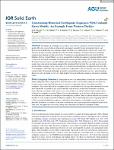Constraining Historical Earthquake Sequences With Coulomb Stress Models: An Example From Western Türkiye
| dc.contributor.author | Diercks, M | |
| dc.contributor.author | Mildon, ZK | |
| dc.contributor.author | Boulton, SJ | |
| dc.contributor.author | Hussain, E | |
| dc.contributor.author | Alçiçek, C | |
| dc.contributor.author | Yıldırım, C | |
| dc.contributor.author | Aykut, T | |
| dc.date.accessioned | 2023-10-27T08:27:07Z | |
| dc.date.available | 2023-10-27T08:27:07Z | |
| dc.date.issued | 2023-11 | |
| dc.identifier.issn | 2169-9313 | |
| dc.identifier.issn | 2169-9356 | |
| dc.identifier.other | ARTN e2023JB026627 | |
| dc.identifier.uri | https://pearl.plymouth.ac.uk/handle/10026.1/21488 | |
| dc.description.abstract |
Knowledge of earthquake source faults is crucial for the calculation of robust Coulomb stress models. However, source faults are often poorly constrained, especially for pre-instrumental events, and these historical earthquakes are commonly studied with little or no consideration of other nearby events. We introduce an approach using Coulomb Stress Transfer (CST) modeling to investigate historical earthquake sequences and constrain possible source faults. Using historical and instrumental records from the Büyük Menderes Graben, western Türkiye, we create an ensemble of earthquake sequences featuring multiple rupture scenarios for individual earthquakes, and model both coseismic and interseismic CST. We filter and evaluate the models based on criteria to gain knowledge on historical earthquakes and their source faults and assess the current stress state and related seismic hazard of the investigated fault network. For our study area, the results provide further constraints on the source faults of several historical earthquakes, including the destructive MW 7.0 earthquake in 1899. The approach presented herein is applicable to other tectonically active areas where the causative faults of historical earthquakes are poorly constrained from existing data sets (e.g., paleoseismology, damage records), providing a new tool to help decipher historical earthquake sequences and improve modeling studies. | |
| dc.language | en | |
| dc.publisher | American Geophysical Union (AGU) | |
| dc.subject | western Anatolian extensional province | |
| dc.subject | coseismic and interseismic stress transfer | |
| dc.subject | earthquake source faults | |
| dc.subject | Buyuk Menderes Graben | |
| dc.subject | historic earthquakes | |
| dc.subject | active tectonics | |
| dc.title | Constraining Historical Earthquake Sequences With Coulomb Stress Models: An Example From Western Türkiye | |
| dc.type | journal-article | |
| dc.type | Article | |
| plymouth.issue | 11 | |
| plymouth.volume | 128 | |
| plymouth.publication-status | Published | |
| plymouth.journal | Journal of Geophysical Research: Solid Earth | |
| dc.identifier.doi | 10.1029/2023jb026627 | |
| plymouth.organisational-group | |Plymouth | |
| plymouth.organisational-group | |Plymouth|Faculty of Science and Engineering | |
| plymouth.organisational-group | |Plymouth|Faculty of Science and Engineering|School of Geography, Earth and Environmental Sciences | |
| plymouth.organisational-group | |Plymouth|REF 2021 Researchers by UoA | |
| plymouth.organisational-group | |Plymouth|Users by role | |
| plymouth.organisational-group | |Plymouth|Users by role|Academics | |
| plymouth.organisational-group | |Plymouth|REF 2021 Researchers by UoA|UoA07 Earth Systems and Environmental Sciences | |
| plymouth.organisational-group | |Plymouth|Users by role|Researchers in ResearchFish submission | |
| dcterms.dateAccepted | 2023-10-10 | |
| dc.date.updated | 2023-10-27T08:26:39Z | |
| dc.rights.embargodate | 2023-10-31 | |
| dc.identifier.eissn | 2169-9356 | |
| rioxxterms.versionofrecord | 10.1029/2023jb026627 |


